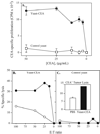Vaccination with a recombinant Saccharomyces cerevisiae expressing a tumor antigen breaks immune tolerance and elicits therapeutic antitumor responses
- PMID: 18594015
- PMCID: PMC2740939
- DOI: 10.1158/1078-0432.CCR-08-0393
Vaccination with a recombinant Saccharomyces cerevisiae expressing a tumor antigen breaks immune tolerance and elicits therapeutic antitumor responses
Abstract
Purpose: Saccharomyces cerevisiae, a nonpathogenic yeast, has been used previously as a vehicle to elicit immune responses to foreign antigens, and tumor-associated antigens, and has been shown to reduce tumor burden in mice. Studies were designed to determine if vaccination of human carcinoembryonic antigen (CEA)-transgenic (CEA-Tg) mice (where CEA is a self-antigen) with a recombinant S. cerevisiae construct expressing human CEA (yeast-CEA) elicits CEA-specific T-cell responses and antitumor activity.
Experimental design: CEA-Tg mice were vaccinated with yeast-CEA, and CD4(+) and CD8(+) T-cell responses were assessed after one and multiple administrations or vaccinations at multiple sites per administration. Antitumor activity was determined by tumor growth and overall survival in both pulmonary metastasis and s.c. pancreatic tumor models.
Results: These studies demonstrate that recombinant yeast can break tolerance and that (a) yeast-CEA constructs elicit both CEA-specific CD4(+) and CD8(+) T-cell responses; (b) repeated yeast-CEA administration causes increased antigen-specific T-cell responses after each vaccination; (c) vaccination with yeast-CEA at multiple sites induces a greater T-cell response than the same dose given at a single site; and (d) tumor-bearing mice vaccinated with yeast-CEA show a reduction in tumor burden and increased overall survival compared to mock-treated or control yeast-vaccinated mice in both pulmonary metastasis and s.c. pancreatic tumor models.
Conclusions: Vaccination with a heat-killed recombinant yeast expressing the tumor-associated antigen CEA induces CEA-specific immune responses, reduces tumor burden, and extends overall survival in CEA-Tg mice. These studies thus form the rationale for the incorporation of recombinant yeast-CEA and other recombinant yeast constructs in cancer immunotherapy protocols.
Figures






Similar articles
-
Intratumoral vaccination and diversified subcutaneous/ intratumoral vaccination with recombinant poxviruses encoding a tumor antigen and multiple costimulatory molecules.Clin Cancer Res. 2004 Feb 1;10(3):1090-9. doi: 10.1158/1078-0432.ccr-03-0145. Clin Cancer Res. 2004. PMID: 14871989
-
Recombinant Saccharomyces cerevisiae (yeast-CEA) as a potent activator of murine dendritic cells.Vaccine. 2008 Jan 24;26(4):509-21. doi: 10.1016/j.vaccine.2007.11.033. Epub 2007 Dec 3. Vaccine. 2008. PMID: 18155327
-
Vaccine therapy of established tumors in the absence of autoimmunity.Clin Cancer Res. 2003 May;9(5):1837-49. Clin Cancer Res. 2003. PMID: 12738742
-
Strategies for the development of recombinant vaccines for the immunotherapy of breast cancer.Breast Cancer Res Treat. 1996;38(1):27-39. doi: 10.1007/BF01803781. Breast Cancer Res Treat. 1996. PMID: 8825120 Review.
-
Mouse models expressing human carcinoembryonic antigen (CEA) as a transgene: evaluation of CEA-based cancer vaccines.Mutat Res. 2005 Aug 25;576(1-2):132-54. doi: 10.1016/j.mrfmmm.2004.10.014. Mutat Res. 2005. PMID: 15888344 Free PMC article. Review.
Cited by
-
Sneaking Out for Happy Hour: Yeast-Based Approaches to Explore and Modulate Immune Response and Immune Evasion.Genes (Basel). 2019 Aug 31;10(9):667. doi: 10.3390/genes10090667. Genes (Basel). 2019. PMID: 31480411 Free PMC article. Review.
-
Saccharomyces cerevisiae (Baker's Yeast) as an Interfering RNA Expression and Delivery System.Curr Drug Targets. 2019;20(9):942-952. doi: 10.2174/1389450120666181126123538. Curr Drug Targets. 2019. PMID: 30474529 Free PMC article. Review.
-
Yeast display platform technology to prepare oral vaccine against lethal H7N9 virus challenge in mice.Microb Cell Fact. 2020 Mar 2;19(1):53. doi: 10.1186/s12934-020-01316-1. Microb Cell Fact. 2020. PMID: 32122351 Free PMC article.
-
Vaccines based on whole recombinant Saccharomyces cerevisiae cells.FEMS Yeast Res. 2010 Dec;10(8):1060-9. doi: 10.1111/j.1567-1364.2010.00665.x. FEMS Yeast Res. 2010. PMID: 20707820 Free PMC article. Review.
-
Harnessing live vectors for cancer vaccines: Advancing therapeutic immunotherapy.Hum Vaccin Immunother. 2025 Dec;21(1):2469416. doi: 10.1080/21645515.2025.2469416. Epub 2025 Mar 24. Hum Vaccin Immunother. 2025. PMID: 40127471 Free PMC article. Review.
References
-
- Franzusoff A, Duke RC, King TH, Lu Y, Rodell TC. Yeasts encoding tumour antigens in cancer immunotherapy. Expert Opin Biol Ther. 2005;5:565–575. - PubMed
-
- Everson G, et al. American Association for the Study of Liver Disease. Boston, MA: 2006. Interim results from a randomized, double-blind, placebo-controlled phase Ib study in subjects with chronic HCV after treatment with GI-5005, a yeast-based HCV immunotherapy targeting NS3 and core proteins.
-
- Whiting SH, Cohn A, Morse MA, O'Neil SB, Bellgrau D, Duke RC, Franzusoff AJ, Munson S, Parker J, Ferraro J, Rodell TC. Treatment of Ras mutation-bearing solid tumor using whole recombinant S. cerevisiae yeast expressing mutated Ras: preliminary safety and immunogenicity results from a Phase I trial; ASCO Gastrointestinal Cancers Symposium; San Francisco, CA: 2006.
-
- Stubbs AC, Wilson CC. Recombinant yeast as a vaccine vector for the induction of cytotoxic T-lymphocyte responses. Curr Opin Mol Ther. 2002;4:35–40. - PubMed
-
- Heintel T, Breinig F, Schmitt MJ, Meyerhans A. Extensive MHC class I-restricted CD8 T lymphocyte responses against various yeast genera in humans. FEMS Immunol Med Microbiol. 2003;39:279–286. - PubMed
Publication types
MeSH terms
Substances
Grants and funding
LinkOut - more resources
Full Text Sources
Other Literature Sources
Research Materials
Miscellaneous

